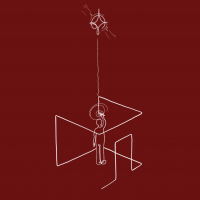Home » Jazz Musicians » Roy Ayers
Roy Ayers
Roy Ayers was during the 1960s one of the most prominentand leading jazz vibraphone players in America. During the1970s and 80s he came to change his focus and becameone of the leading figures in R&B and jazz/funk. The 1990shas once again brought him into a new direction and he isnow regarded being one of the greatest innovators of theacid jazz movement. His music has often been described asbeing years ahead of it's time.
Ayers was born on September 10, 1940, in Los Angeles,California. Thanks to the influence of his mother, a pianoteacher, and his father, a trombone player, Ayers was amusical child. His introduction to the vibraphone came at theage of six, when his parents took him to a Lionel Hamptonconcert. After the show, Hampton handed Ayers a pair ofmallets, sealing the youngster's musical destiny with thatsimple gesture. It was not until he was 17 years old thatAyers finally got a chance to play the vibraphone, which heclaims had been his favorite instrument all along.
By the early 1960s, Ayers was playing regularly with anumber of local performers, including such fixtures on theLos Angeles jazz scene as Teddy Edwards, ChicoHamilton, and Jack Wilson. This experience soon gaveAyers the necessary confidence to become a band leader.His first opportunity to record in that capacity came in 1963,on a project called “West Coast Vibes,” released by UnitedArtists. In 1966 Ayers, at the invitation of bassist ReggieWorkman, sat in on a gig with Herbie Mann and his Quintet,at the Lighthouse, a prominent Los Angeles jazz club. Mannwas so impressed with his work that he immediately madeAyers a permanent member of the group. Ayers toured andrecorded with Mann for the next four years, a period thatincluded the release of Mann's smash hit LP, “MemphisUnderground” During this stint, Ayers also recorded threesolo albums--all produced by Mann: “Daddy Bug,” “VirgoRed,” and “Stoned Soul Picnic.”
Ayers left the Mann group in 1970, and moved to New York,where he quickly formed his own band, which he dubbedUbiquity. Ubiquity did not have a stable lineup like aconventional band. It consisted instead of a constantly-shifting roster of musicians at various stages in theircareers. The band included established pros like bassistRon Carter and saxophonist Sonny Fortune; newcomervocalist Dee Dee Bridgewater; and others. Ayers usedUbiquity to create a new genre that borrowed elements fromjazz, funk, rock, soul, salsa, and whatever else he heard andliked, and then synthesized them into an appealing melange.
The next dozen years represented an incredibly prolificperiod for Ayers and the various versions of Ubiquity.During that span, the group recorded no less than 20albums for Polydor. Ayers spent the first half of theseventies building an audience for his new musical mixture.His approach was to incorporate anything that he thoughtsounded good. "I have a totally open mind about music," hewas quoted as saying in the liner notes to the 1995compilation Evolution: The Polydor Anthology. "I love themusic I listen to-- pop, jazz, blues and soul--and I'm notclosed to them. My music is a combination of styles fusedinto one. I like to cover the total perspective," he continued.He also experimented quite a bit with his own instrument,becoming one of the first vibes players to alter theinstrument's sound with fuzz boxes, wah-wah pedals, andother effects more commonly associated with the electricguitar. At times, the vibes were a featured solo instrument,with Ayers taking off on extended flights of mallet fancy. Justas often, however, his vibes lurked in the background,shimmering behind riffing keyboards, guitars, and horns, alldriven by a thumping rhythm section.
Read moreTags
Two hours of Roy Ayers as a sideman, and his earlier work as a leader

by Andy Crowther
A real journey of discovery and education for me here, I learnt so much and hope you do too. Two hours of Roy as a sideman, and his early work as a leader. Playlist Curtis Amy Featuring Victor Feldman “A Soulful Bee, A Soulful Rose" from Way Down (Pacific Jazz) 00:00 Gerald Wilson Orchestra “Lighthouse Blues" from On Stage (Pacific Jazz) 09:48 Curtis Amy “Tippin' on Through" from Tippin' On Through (Pacific Jazz) 17:13 Vi Redd “Medley: Perhaps ...
Continue ReadingRoy Ayers, Kwashibu Area Band, Red Snapper, Calibro 35, Manu Dibango, John Lamkin, & More

by Tony Poole
The show opens with a brief tribute to the late Roy Ayers and a special moment from my 1990 interview for BBC Essex with Roy during his first residency at Ronnie Scott's. In a jovial mood, he recalls the time he “felt like a Beatle"--a wild night at the Hammersmith Odeon, London, in 1978 when the crowd rushed the stage. Check out this hilarious clip. Playlist Roy Ayers “I felt like a Beatle" interview clip Roy Ayers “Everytime ...
Continue ReadingRoy Ayers: A Retrospective

by Jason Elias
Vibraphonist, singer and producer Roy Ayers is a master of many musical styles and genres, from acid-jazz, jazz-funk to romantic ballads and dance tracks. While many of his contemporaries seemed to fail when they tried different sounds, Ayers always made sure a certain of musicality and identity was apparent in all of his work. Ayers's first album was 1963's West Coast Vibes and it was issued on United Artists Records. Ayers spent the next few years as a ...
Continue ReadingRoy Ayers at Yoshi's

by Walter Atkins
Roy Ayers is Everywhere Yoshi's Oakland Oakland California November 27, 2015 The venerable vibraphonist Roy Ayers and his seasoned band performed during a sold out weekend at the East Bay's popular Yoshi's in Oakland's Jack London Square. The exuberant 75-year-old composer /musician opened the exciting second show with “Sweet Tears." Ayers surprised the full house by taking his band into his arrangement of Rick James' funky number one RB hit “Give It To Me Baby" ...
Continue ReadingRoy Ayers: West Coast Vibes

by Nic Jones
Roy Ayers had a career before he had hit records, and this reissue proves the vibraphonist was both well-versed and eloquent within the realm of post-bop jazz. In the company largely of a cast including pianist Jack Wilson and Curtis Amy on tenor and soprano saxophones, Ayers works his way through the kind of programme of standards and originals that was pretty much the order of the day back in the early 1960s. This does not, however, alter the fact ...
Continue ReadingRoy Ayers: Stoned Soul Picnic

by Douglas Payne
Stoned Soul Picnic is vibraphonist Roy Ayers' third and probably best solo album, made in 1968 while he was still a part of Herbie Mann's group. Ayers stands clearly in the shadow of Bobby Hutcherson on this primarily modally-oriented date, sounding nothing like the groove-meister he would become known as later in the 1970s.Producer Mann, always an underrated talent scout, assembles an especially exceptional septet for Ayers here with Gary Bartz on alto sax, arranger Charles Tolliver on ...
Continue ReadingRoy Ayers (1940-2025)

Source:
JazzWax by Marc Myers
Roy Ayers, a vibraphonist, record producer and composer who created a new jazz sound in the mid-1970s that combined electronic jazz, trippy funk and soothing soul that rested heavily on mellow chord sequences and lyrical melodies, died on March 4. He was 84. Ayers began by recording hard bop in 1962 with Curtis Amy and recorded his first leadership album, West Coast Vibes (United Artists), a year later. He broadened his approach in 1966 when he teamed with jazz and ...
read more
Roy Ayers + Maceo Parker

Source:
JazzWax by Marc Myers
Roy Ayers and Maceo Parker are two of my favorite jazz-soul and jazz-funk artists. Both recently released new albums. And both musicians started out as jazz players but invented new R&B forms during their careers—Ayers as a neo-soul vibraphonist and Parker as a bump-and-funk alto saxophonist. Their new albums are moody, funky and chill. Ayers is probably best known for his 1976 album Everybody Loves the Sunshine. Parker emerged in the 1960s as a saxophonist for James Brown and then ...
read more
Roy Ayers: Jazz-Soul Godfather

Source:
JazzWax by Marc Myers
By the late 1960s and very early '70s, a growing number of young jazz musicians saw the writing on the wall. Rock was attracting massive media attention, ever-larger crowds of young listeners, and larger paydays. To compete, many jazz artists gave up their acoustic instruments for electronic counterparts and began playing a new form of jazz that was heavily influenced by hard rock and psychedelic mysticism. But not all jazz musicians determined to remain relevant rushed to embrace rock. Some ...
read more
2015 Art of Cool Jazz Festival

Source:
Michael Ricci
By K. Shackelford The 2015 Art of Cool Jazz Festival is a journey into the immense vastness of jazz music with a roster of world class musicians. Operating in only its second year, the three day jazz dreamland, offers a superb mix of old and new artists that illuminate the ways that jazz penetrates many forms of American music. The festival will occur in Durham, North Carolina on April 24-26, 2015. The line-up at AOCFEST is a hefty ...
read more
Roy Ayers at The Addition

Source:
Michael Ricci
By Walter Atkins The Addition, formally known as Yoshi's San Francisco, welcomed the celebrated and ageless acid jazz/funk vibraphonist Roy Ayers for a weekend stand on November 21, 2014. The new name was inspired by the club's location between Lower Fillmore and the Western Addition. The show kicked off the soft opening of the City's latest music venue. According to his official website, the respected and heavily sampled vibraphonist/vocalist is considered the “The Godfather of Neo Soul." Vocalist ...
read more
Jammin’ at the Gem Concert Series Showcases Vibraphonist Roy Ayers with Spoken Word and Jazz Poetry Innovators

Source:
Artists Recording Collective + the ARC Record Label
The second installment in the American Jazz Museum's noted 2011/2012 “Jammin' at the Gem" concert series season headlines another musical master of world renown, the vibraphonist/composer, Roy Ayers. Mr. Ayers will be joined by two pioneers of jazz poetry and spoken word, Jessica Care Moore and Louis Reyes Rivera. Of poets, Moore and Reyes Rivera, AJM Poet-In-Residence, Glenn North states, “Jessica Care Moore was the first poet who appeared on “Showtime at the Apollo" to win 5 times in a ...
read more
Jazz Poetry Pioneers at Jammin' at the Gem in February

Source:
Artists Recording Collective + the ARC Record Label
The next concert in the Jammin' at the Gem series features Valentine and Black History Month and a Salute to Jazz Poetry. The Jazz Poetry Jams program at the American Jazz Museum is in its 9th year. The combining of jazz music performance and jazz poetry on the Gem Theater stage in concert is scheduled for Saturday, February 11, 2012 at 8:00 pm with the legendary Roy Ayers performing with jazz poetry pioneers: Louis Reyes Rivera and Jessica Care Moore. ...
read more
Roy Ayers: Soul Vibes

Source:
JazzWax by Marc Myers
Back in the early 1970s, Chick Corea, Stanley Clarke, Tony Williams and John McLaughlin leveraged Miles Davis' new electric approach to jazz and created different streams of jazz-rock fusion. At the same time, vibraphonist Roy Ayers went off in a separate direction—pioneering electronic jazz-funk, which Herbie Hancock would build on with Headhunters in 1973. This Thursday, Nov. 17, Ayers will make a rare performance appearance in Los Angeles at the Exchange LA club, from 8 p.m. to 2 a.m. Go ...
read more
The Godfather of Neo-Soul, Roy Ayers Takes over at the World Famous Blue Note Jazz Club, NYC.

Source:
All About Jazz
On October 29th and 30th, Roy Ayers will be making his debut at New York City’s legendary Blue Note Jazz Club on West 3rd Street in the prominent East Village. At 8:00 PM and 10:30 PM on two consecutive evenings, the renowned icon will appear on stage performing a plethora of his chart topping hits and eternally revived tunes.
As one of the greatest living vibraphonists and vocalists, Roy Ayers is among the best-known, most-loved and respected Jazz and R&B ...
read more































.jpg)

















